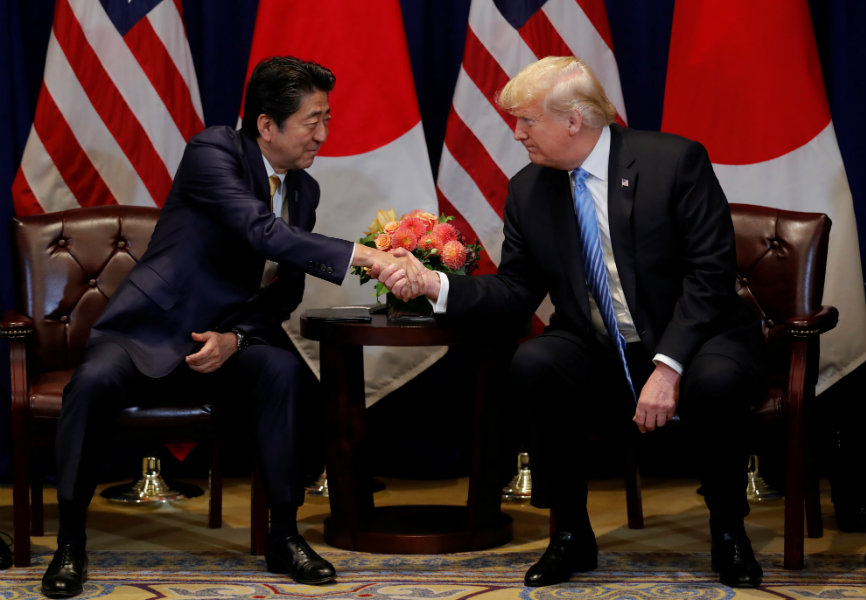
Last week, the White House announced that the United States had reached two agreements with Japan. This week, on the margins of the United Nations General Assembly (UNGA), President Trump and Japanese Prime Minister Abe issued a joint statement that they had concluded a limited trade deal on agricultural and industrial tariffs and digital trade. It does not include any exemption for Japan from auto tariffs imposed on national security grounds - Japan's primary motivation for the negotiations. This post looks at the summary of the agreement, for which no text has been provided, and considers how it fits into the pattern of Trump administration negotiations.
Fact sheets issued by the U.S. Trade Representative outlined the agreement, emphasizing the agricultural results. Under this first-stage tariff agreement, Japan will provide greater market access for U.S. agricultural products by eliminating or lowering tariffs on $7.2 billion of U.S. food and agricultural products, including beef, pork and some dairy products. For other agricultural commodities such as wheat, Japan will provide U.S.-specific quotas.
For its part, the U.S. will eliminate or reduce tariffs on agricultural imports from Japan valued at only $40 million, covering products such as flowers, persimmons, green tea, gum and soy sauce. The U.S. also agreed to modify its global WTO tariff rate quota (TRQ) for Japanese beef imports, so Japanese beef producers can compete for a larger share of the global TRQ. The agreement will allow Japan’s limited use of safeguards “for surges in imports of beef, pork, whey, oranges, and race horses.” The U.S. also agreed to reduce or eliminate tariffs on certain industrial goods from Japan such as machine tools, turbines, bicycles, bicycle parts and musical instruments.
The new trade pact includes a separate agreement on digital trade, which according to USTR “meets the gold standard on digital trade rules set by the [U.S.-Mexico-Canada Agreement].” It prohibits duties on digital products transmitted electronically and data localization requirements.
The U.S. and Japanese leaders indicated that they would sign the new agreement “as quickly as possible” and “aim to implement it at the earliest time after completing the various domestic procedures.” That means approval by the Japanese Diet, but not Congress. The leaders have agreed that these early outcomes will be followed by further negotiations to address remaining areas of interest to each government.
The U.S. has achieved its primary goal – increased market access for U.S. farmers and ranchers to the Japanese market to regain at least some of what the U.S. lost when President Trump pulled the U.S. out of the Trans-Pacific Partnership at the start of his presidency. The U.S. insisted on the negotiations because its agricultural trade was losing ground to competition from parties to the renamed Comprehensive and Progressive Trans-Pacific Partnership, which entered into force at the end of 2018 (without the U.S.), and the Japan-European Union agreement, implemented in February. Both agreements provide preferential access to Japan’s agricultural market.
The new agreement does not address Japan’s most important aim – a commitment that it would not be hit with auto tariffs under the president’s determination that auto imports threaten the national security. USTR has indicated that those tariffs will be taken up in the next phase of the negotiations. However, it appears that Prime Minister Abe gave away his most important bargaining leverage - agricultural market access, without securing a concrete commitment on auto tariffs. What incentive will the U.S. have to address the auto tariffs issue in subsequent negotiations? Or what would stop it from again using the threat of auto tariffs to extract new concessions from Japan?
The administration’s negotiations with Japan follow a now familiar pattern: impose tariffs or threaten to impose tariffs - or withdraw from existing agreements - as leverage to get a trading partner to the negotiating table to address U.S. trade issues. That approach was used with Korea to revise their trade agreement and with Canada and Mexico to force a renegotiation of the North American Free Trade Agreement (NAFTA). The administration removed steel and aluminum tariffs on Canada and Mexico months after they completed negotiations, and only have Congress set their removal as a condition for approving the new agreement. Trump's "America First" policy, reiterated in his UNGA speech this week, leaves little room for reciprocal consideration of the interests of U.S. trading partners.
Jean Heilman Grier
September 26, 2019
Related Posts
Post Permalink: https://trade.djaghe.com/us-japan-deal-no-auto-tariff-exemption/

